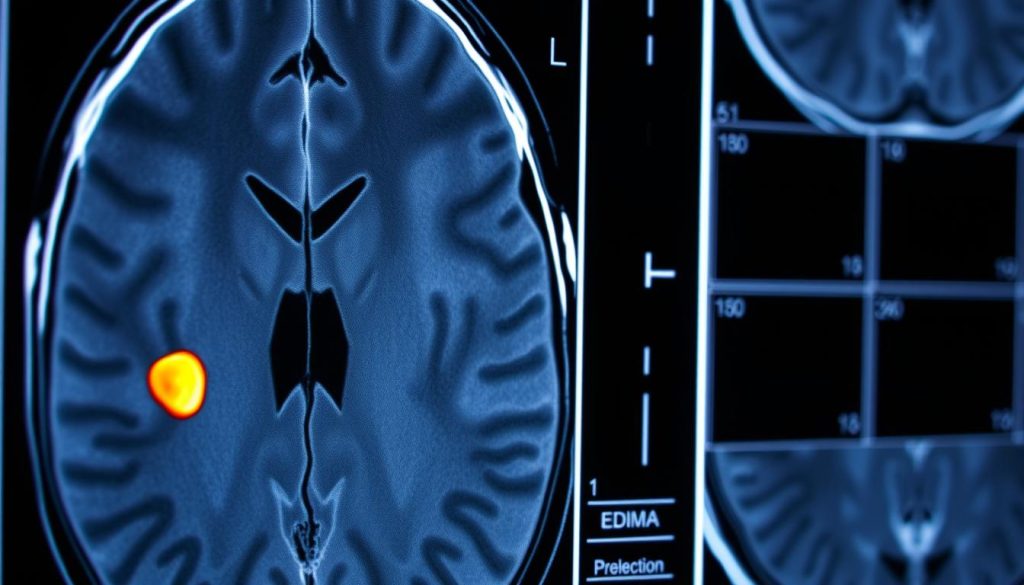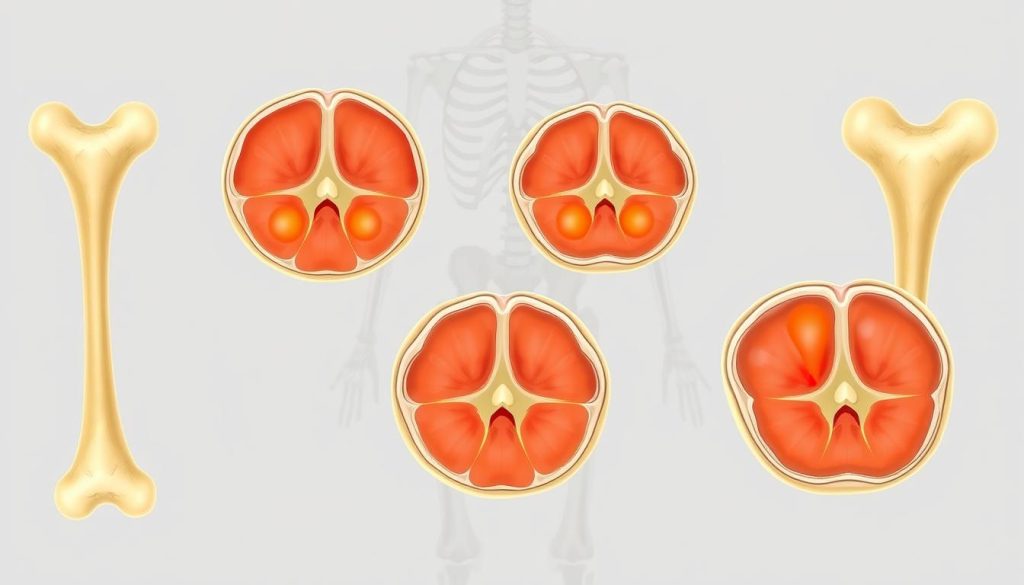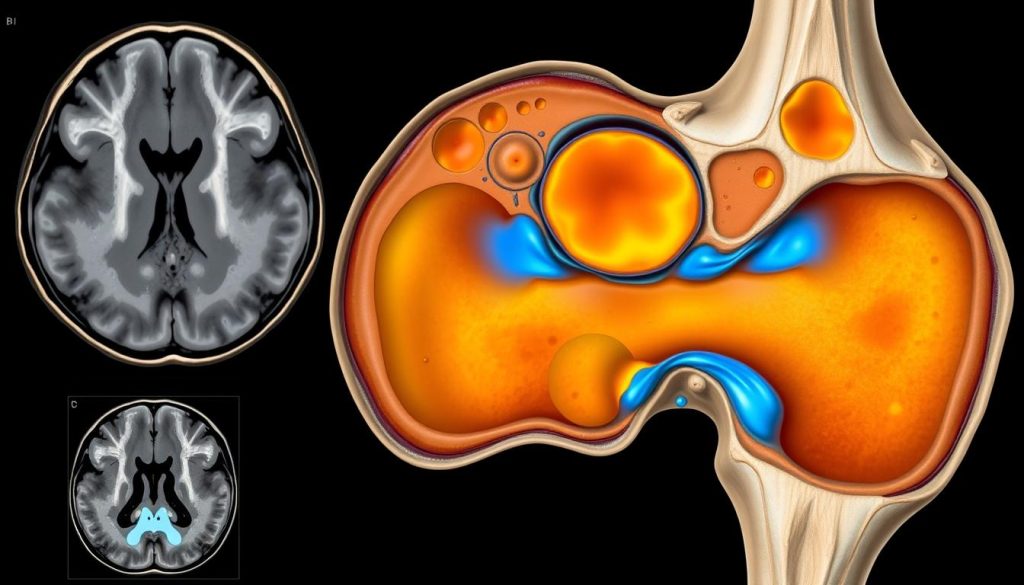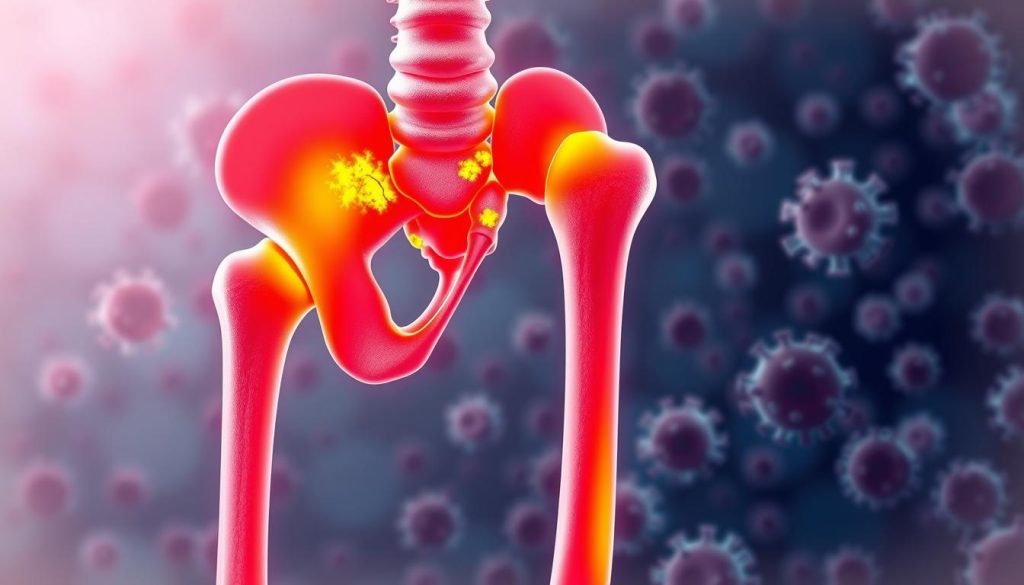When you hear about bone marrow edema, many questions pop up. One big worry is: can it be cancer? It’s natural to worry about the worst when you hear about any health issue. But, it’s key to think clearly and quickly.
The American Cancer Society, Mayo Clinic, and National Institute of Health have lots of info. They say bone marrow edema symptoms don’t always mean you’re at high risk for cancer. This condition can be caused by many things, and its connection to cancer needs a detailed check-up.
To figure out if bone marrow edema means cancer, we need to look closely at symptoms and tests. It’s not just important but crucial to understand this clearly. Saying all bone marrow edema is cancer would be wrong and could make patients even more worried.
Key Takeaways
- Not all bone marrow edema diagnoses lead to cancer.
- Bone marrow edema symptoms require careful examination and professional medical advice.
- Diagnostic processes are crucial in determining the bone marrow cancer risk associated with bone marrow edema.
- Medical guidance from reputable sources like the American Cancer Society, Mayo Clinic, and National Institute of Health is invaluable.
- Understanding the complexities of bone marrow edema can provide peace of mind and direction for further action.
Understanding Bone Marrow Edema
Bone marrow edema is more than just a term; it’s a condition that could signal several health issues. Knowing its nature, how common it is, and what causes it is key. This knowledge is vital for those affected and their caregivers.
What is Bone Marrow Edema?
Bone marrow edema is when fluid builds up in the bone marrow. It often means there’s an underlying problem. Through bone marrow edema diagnosis, it’s seen as a sign of many conditions, from simple to serious like cancer.
How Common is Bone Marrow Edema?
Bone marrow edema isn’t well-counted since it often shows up with other issues. Yet, MRI scans used in bone marrow edema diagnosis reveal it’s common. This is especially true for people with joint pain or injuries.
Typical Causes and Risk Factors
Knowing what causes bone marrow edema helps understand it better. Several factors can lead to it:
- Trauma: Injury, either sudden or repeated, can cause it.
- Inflammation: Conditions like arthritis or osteoporosis can start it.
- Systemic conditions: Anemia or autoimmune diseases also play a part.
Bone marrow edema can come from many bone marrow edema causes. This makes it important to have a personalized approach to diagnosis.
| Cause Category | Examples |
|---|---|
| Traumatic | Sports injuries, accidents |
| Inflammatory | Arthritis, osteoporosis |
| Systemic | Anemia, autoimmune diseases |
Every person’s path to understanding and managing bone marrow edema is different. This means they need a diagnosis and treatment plan that fits their specific situation.

With this knowledge, both patients and doctors can better handle the challenges of bone marrow edema diagnosis and treatment.
Identifying the Symptoms of Bone Marrow Edema
Spotting bone marrow edema symptoms is key for quick and effective bone marrow edema treatment. This condition causes pain and discomfort, making daily tasks hard if not treated. Here, we list the main symptoms of bone marrow edema, based on real-life experiences.
- Persistent pain in the affected area, which may worsen with physical activity
- Noticeable swelling and tenderness at the site
- Stiffness in the joints near the affected bone marrow
- Increased pain during the night or while resting
- Limited range of motion in nearby joints
These symptoms often push people to see a doctor. If you’re showing these signs, seeing a healthcare provider is important to avoid more problems. Our information comes from the Johns Hopkins Arthritis Center and the National Institute of Health. This ensures our talk on bone marrow edema treatment and symptoms is backed by solid medical research.

Knowing these symptoms helps in early detection and talking about treatment with doctors. If you or someone you know has these signs, think about bone marrow edema. Make sure to get medical help quickly to look at treatment options.
Remember, every individual’s experience with bone marrow edema can vary significantly; thus, personal symptoms should always be assessed in consultation with healthcare providers.
Can Bone Marrow Edema be Cancer?
It’s important to know if bone marrow edema could be cancer. While it’s not a cancer diagnosis on its own, some cases need checking. This is to rule out malignant bone marrow edema. Doctors must carefully check to tell if it’s benign or malignant.
Bone marrow edema can be scary, making people worry about bone marrow cancer detection. But, not all edema is cancer. Many times, it’s due to injuries or osteoarthritis. Still, it’s key to check it out to see if it might be cancer.
The table below shows the differences between benign and malignant bone marrow edema:
| Feature | Benign Bone Marrow Edema | Malignant Bone Marrow Edema |
|---|---|---|
| Common Causes | Trauma, inflammatory arthritis | Metastasis, primary bone tumors |
| Imaging Features | Localized edema | Diffuse edema with irregular patterns |
| Symptom Onset | Gradual, correlating with activity | Rapid, often without clear causes |
| Treatment Response | Positive response to conservative treatment | Potentially aggressive, often requires more intensive treatment |
This table is a guide. Always talk to doctors who specialize in bone marrow cancer detection and treatment.

It’s important to watch your health and see doctors if you have bone marrow edema. This is especially true if symptoms don’t go away.
Not every bone marrow edema is cancer. It’s important to talk to doctors to understand what’s going on. This helps with health care and reduces worry for patients.
Diagnostic Processes for Bone Marrow Edema
Diagnosing bone marrow edema starts with a detailed look at the patient’s history and a thorough check-up. Advanced imaging is used to see how bad the edema is and where it is. Sometimes, a biopsy is needed to find out the exact cause or to check for cancer.
Clinical Examinations and Patient History
The first step is to check the patient’s symptoms and pain levels. Doctors also look at any recent injuries or past health issues. This helps figure out if the patient is at risk for bone marrow edema or if they have conditions like osteoarthritis.
Imaging Techniques in Identifying Bone Marrow Edema
Imaging, especially MRI, is key in diagnosing bone marrow edema. It helps tell it apart from other conditions. MRI shows how severe the edema is and where it is in the bone marrow. Learn more about this condition.
The Role of Biopsies in Bone Marrow Analysis
If imaging doesn’t give clear answers or if there’s a worry about cancer, a biopsy might be done. It takes a small sample of bone marrow tissue. This sample is then checked for cancer cells or other signs of serious problems.

Bone Marrow Edema and Cancer Correlation
Looking into the connection between bone marrow edema and cancer shows a complex link. It’s key for both patients and doctors to grasp. This is especially true when thinking about bone marrow cancer risk. Studies highlight the need to study this link closely to improve health outcomes.

Medical journals like Clinical Lymphoma, Myeloma & Leukemia and American Journal of Hematology agree. Bone marrow edema isn’t the same as cancer, but it’s a warning sign. It often shows up with other symptoms that might point to serious diseases, like cancer.
Recent studies show a deep but complex bond between bone marrow edema and cancer risks. This bond calls for a careful approach to diagnosis and treatment. It’s important to make sure patients get full checks to handle any risks from bone marrow problems.
| Condition | Indication of Bone Marrow Edema | Associated Cancer Risk |
|---|---|---|
| Osteoarthritis | Commonly Present | Minimal |
| Trauma | Frequently Present | Low |
| Malignancy | Occasionally Present | High |
Understanding this link gives us important insights. It shows how a seemingly harmless condition can turn into serious health problems, like cancer. So, early and accurate detection is key in healthcare. It’s especially important for checking bone marrow cancer risk.
Treatment Options for Bone Marrow Edema
Understanding the different treatments for bone marrow edema is key. Treatments range from non-surgical to surgical options. Each has its own goals and success rates.
Non-Surgical Interventions and Their Effectiveness
Non-surgical treatments are often the first choice. They aim to ease symptoms and fix the cause without surgery. These include:
- Medication such as anti-inflammatory drugs to reduce pain and swelling.
- Physical therapy to improve joint function and reduce stress on the bone.
- Orthotic support to redistribute weight and ease pressure on affected areas.
These treatments are recommended for mild to moderate cases. They are often effective in managing symptoms.
Surgical Treatments and When They Are Necessary
Surgery is considered when other treatments don’t work. It’s needed for structural problems that need fixing. Procedures may include:
- Core decompression to relieve pressure inside the bone.
- Bone grafting to replace damaged bone and support regrowth.
Surgery is a last resort but sometimes necessary. It helps prevent further bone damage and improves quality of life.
Follow-Up Care and Management of Bone Marrow Edema
Managing bone marrow edema doesn’t stop after treatment. Follow-up care is vital for long-term health. This includes:
- Regular monitoring through imaging to assess the healing process.
- Ongoing physical therapy and adjustments in lifestyle and activity levels.
- Education on protective measures to avoid future injuries or exacerbation.
Following a detailed management plan is crucial. It helps patients regain and maintain bone health.
| Treatment Type | Use Case | Effectiveness |
|---|---|---|
| Medication | Mild to moderate edema | Highly effective in early stages |
| Physical Therapy | All severity levels | Varies with patient compliance and condition |
| Surgery | Severe cases or structural issues | Essential for long-term resolution |
Malignant Bone Marrow Edema: Causes and Prognosis
Malignant bone marrow edema is a serious issue linked to bone tumors or cancer spread. Knowing how it starts helps in catching bone marrow cancer early. We’ll look at the main reasons and what happens after a diagnosis.
This condition often comes from cancer cells spreading to the bone from other places. This usually happens from the breast, prostate, or lungs. It changes the bone marrow, causing inflammation and fluid buildup.
Prognosis depends on the cancer’s type and how early it’s found. Catching bone marrow cancer early is key to managing it. Advanced imaging and biopsies are crucial for diagnosis and treatment plans.
| Cancer Type | Frequency of Associated Malignant Bone Marrow Edema | Typical Prognosis |
|---|---|---|
| Breast Cancer | High | Varies; dependent on stage at detection |
| Prostate Cancer | Medium | Generally favorable with early treatment |
| Lung Cancer | High | Often severe; early detection critical |
The table shows how different cancers can lead to malignant bone marrow edema. It stresses the importance of watching patients closely and acting fast.
Assessing Bone Marrow Cancer Risk
It’s important to know the risks and signs of bone marrow cancer for early detection and prevention. This section will look at the key markers and data on who might be at higher risk.
Markers and Indicators for Bone Marrow Cancer
Research shows that some genetic markers and immune profiles can raise bone marrow cancer risk. For example, changes in chromosomes like deletions or translocations can be warning signs. Also, high levels of specific proteins in blood tests often point to a higher risk.
Statistical Risk Factors for Developing Bone Marrow Cancer
Lifestyle and environmental factors also play a big role in bone marrow cancer risk. Long-term exposure to radiation, certain chemicals, and heavy smoking increase the risk. Family history is also important, making targeted screening crucial for those at risk.
| Risk Factor | Increased Risk Percentage |
|---|---|
| Genetic predisposition | 25% |
| Radiation exposure | 20% |
| Chemical exposure | 15% |
| Smoking | 30% |
| Previous cancer treatments | 10% |
By carefully looking at these factors, we can improve bone marrow cancer detection. This could lead to better treatment outcomes by catching the disease early.
Advanced Techniques in Bone Marrow Cancer Detection
Medical technology keeps getting better, helping us find and treat bone marrow cancer. New advanced bone marrow cancer detection tools bring hope to patients and doctors. These new methods are key, especially for dealing with bone marrow edema and cancer.
Innovations in Imaging for Early Diagnosis
New imaging tools have changed how we diagnose bone marrow edema and cancer. High-resolution MRI scanners show bone marrow in detail, helping spot cancer early. This tech, with better software, can tell the difference between normal and cancerous bone marrow.
Molecular and Genetic Testing Developments
Genetic and molecular tests have also improved a lot. Doctors can now find specific genetic signs of bone marrow cancers. This helps in early detection and creates treatment plans that fit each person’s cancer.
To learn more about managing bone marrow edema, check out this consensus paper. It talks about how doctors worldwide work together to diagnose and treat it.
These advanced bone marrow cancer detection methods are a big step forward. They help make cancer care more accurate, timely, and tailored to each patient. This leads to longer lives and better health for those with cancer.
Living with Bone Marrow Edema
When you’re diagnosed with bone marrow edema, changing your lifestyle is crucial. It’s important to understand how to manage this condition. This helps keep your quality of life high and reduces stress related to treatment.
Life with bone marrow edema means more doctor visits and changes in your daily routine. By following effective treatments and wellness practices, you can stay strong and in control of your health.
- Dietary Adjustments: Eating foods that fight inflammation can help.
- Physical Activity: Doing exercises that your doctor approves helps keep you moving without making symptoms worse.
- Regular Monitoring: Keeping an eye on how you’re doing and any changes in symptoms is key for adjusting your treatment plan.
Having a support system is very important when you live with bone marrow edema. Joining online or local support groups can offer emotional support and valuable advice from others who understand what you’re going through.
Sharing experiences and tips on managing bone marrow edema treatment can inspire others. It also brings hope and practical advice to your own life.
| Aspect of Management | Benefits |
|---|---|
| Medical Consultations | Personalized treatment adjustments and expert guidance |
| Support Groups | Emotional support and sharing of practical knowledge |
| Mental Health Care | Techniques to cope with stress and improve psychological well-being |
Keeping a positive outlook is key when you live with bone marrow edema. Medical research is always improving treatments. This brings hope and better outcomes for those affected.
Conclusion
We’ve looked into bone marrow edema and its link to cancer risks. We’ve covered symptoms, how to diagnose it, and treatment options. Sources like the Journal of the American Medical Association and Clinical Orthopaedics and Related Research helped us understand it well.
Knowing how to diagnose bone marrow edema quickly is key. It helps manage the condition and decide on the right treatment. Treatment plans vary, from non-invasive methods to surgery, depending on the situation.
This knowledge helps us see the risk of bone marrow cancer. But it also tells us that with the right info and medical help, we can face bone marrow edema. It shows how important it is to take care of our health and stay close to our doctors.
It’s all about being proactive with our health. Knowing the symptoms, staying updated on diagnosis methods, and understanding treatment options helps. This way, patients and their families can face the future with hope and strength.
FAQ
Q: Is Bone Marrow Edema a Sign of Cancer?
A: Bone marrow edema is not always a sign of cancer. It can be linked to cancer, but also to other conditions. To know if it’s cancer, doctors look at symptoms and do tests.
Q: What is Bone Marrow Edema?
A: Bone marrow edema is when too much fluid builds up in the bone marrow. It’s often seen with imaging like MRI.
Q: How Common is Bone Marrow Edema?
A: We don’t know how common bone marrow edema is. It often happens with other health issues. It can affect anyone, based on the cause.
Q: What are Typical Causes and Risk Factors for Bone Marrow Edema?
A: Bone marrow edema can be caused by trauma, inflammatory diseases, or osteoarthritis. Risk factors include overuse injuries and autoimmune disorders.
Q: What are the Symptoms of Bone Marrow Edema?
A: Symptoms include pain and discomfort in the affected area. These symptoms might lead someone to see a doctor, especially if they get worse.
Q: How is Bone Marrow Edema Diagnosed?
A: Doctors use exams, patient history, and imaging like MRI to diagnose. Sometimes, they need to take a biopsy to check the bone marrow.
Q: Can Bone Marrow Edema Develop into Cancer?
A: Bone marrow edema itself doesn’t turn into cancer. But, it can be a sign of cancer in the bone marrow. It’s important to get a proper evaluation.
Q: What are the Treatment Options for Bone Marrow Edema?
A: Treatment can be non-surgical, like medicine and physical therapy, or surgery in severe cases. The choice depends on the cause and how severe it is.
Q: What is Malignant Bone Marrow Edema?
A: Malignant bone marrow edema is when edema is caused by cancer in the bone or marrow. It needs immediate medical attention and a specific treatment plan.
Q: How Can I Assess My Bone Marrow Cancer Risk?
A: Assessing risk involves looking at your and your family’s health history, genetic tests, and lifestyle. Doctors use markers and indicators to determine your risk.
Q: What are the Latest Techniques in Bone Marrow Cancer Detection?
A: New imaging and genetics have improved early detection of bone marrow cancer. These methods are more precise and less invasive.
Q: How Can I Manage Living with Bone Marrow Edema?
A: Managing bone marrow edema means making lifestyle changes, following treatment, and using support systems. Being informed and proactive is key for a good quality of life.












